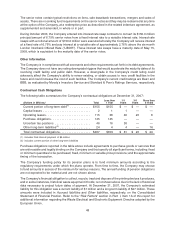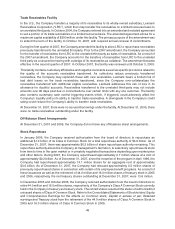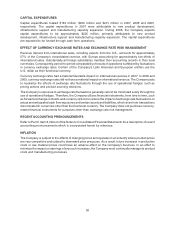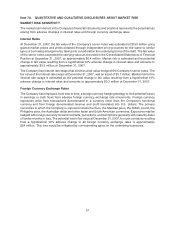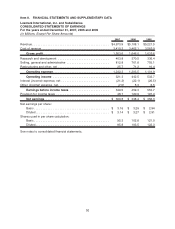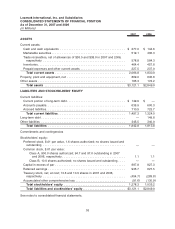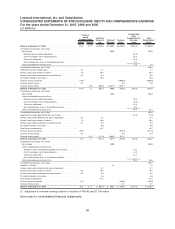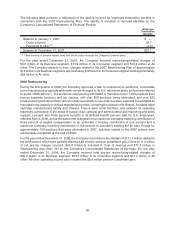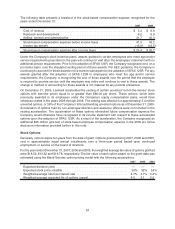Lexmark 2007 Annual Report Download - page 63
Download and view the complete annual report
Please find page 63 of the 2007 Lexmark annual report below. You can navigate through the pages in the report by either clicking on the pages listed below, or by using the keyword search tool below to find specific information within the annual report.temporary declines in value by considering various factors that include, among other things, any events
that may affect the creditworthiness of a security’s issuer, the length of time the security has been in a loss
position and the Company’s ability and intent to hold the security until a forecasted recovery of fair value
that may include holding the security to maturity. Realized gains or losses are included in net earnings and
are derived using the specific identification method for determining the cost of the securities.
Allowance for Doubtful Accounts:
Lexmark maintains allowances for doubtful accounts for estimated losses resulting from the inability of its
customers to make required payments. The Company estimates the allowance for doubtful accounts
based on a variety of factors including the length of time receivables are past due, the financial health of its
customers, unusual macroeconomic conditions and historical experience. If the financial condition of its
customers deteriorates or other circumstances occur that result in an impairment of customers’ ability to
make payments, the Company records additional allowances as needed.
Fair Value of Financial Instruments:
The financial instruments of the Company consist mainly of cash and cash equivalents, marketable
securities, trade receivables, trade payables, short-term debt, current portion of long-term debt and
derivatives. The fair value of cash and cash equivalents, trade receivables, trade payables and short-term
debt approximates their carrying values due to the relatively short-term nature of the instruments. The fair
value of Lexmark’s marketable securities are based on quoted market prices or other observable market
data, or in some cases, the Company’s amortized cost, which approximates fair value due to the frequent
resetting of interest rates resulting in repricing of the investments. The fair value of the current portion of
long-term debt is estimated based on current rates available to the Company for debt with similar
characteristics. The fair value of derivative financial instruments is based on pricing models or
formulas using current market data, or where applicable, quoted market prices.
Inventories:
Inventories are stated at the lower of average cost or market using standard costs, which approximates the
average cost method of valuing its inventories and related cost of goods sold. The Company considers all
raw materials to be in production upon their receipt.
Lexmark writes down its inventory for estimated obsolescence or unmarketable inventory equal to the
difference between the cost of inventory and the estimated market value. The Company estimates the
difference between the cost of obsolete or unmarketable inventory and its market value based upon
product demand requirements, product life cycle, product pricing and quality issues. Also, Lexmark
records an adverse purchase commitment liability when anticipated market sales prices are lower than
committed costs.
Property, Plant and Equipment:
Property, plant and equipment are stated at cost and depreciated over their estimated useful lives using the
straight-line method. Property, plant and equipment accounts are relieved of the cost and related
accumulated depreciation when assets are disposed of or otherwise retired.
Internal Use Software Costs:
Lexmark capitalizes direct costs incurred during the application development and implementation stages
for developing, purchasing, or otherwise acquiring software for internal use. These software costs are
included in Property, plant and equipment, net, on the Consolidated Statements of Financial Position and
are depreciated over the estimated useful life of the software, generally three to five years. All costs
incurred during the preliminary project stage are expensed as incurred.
57



